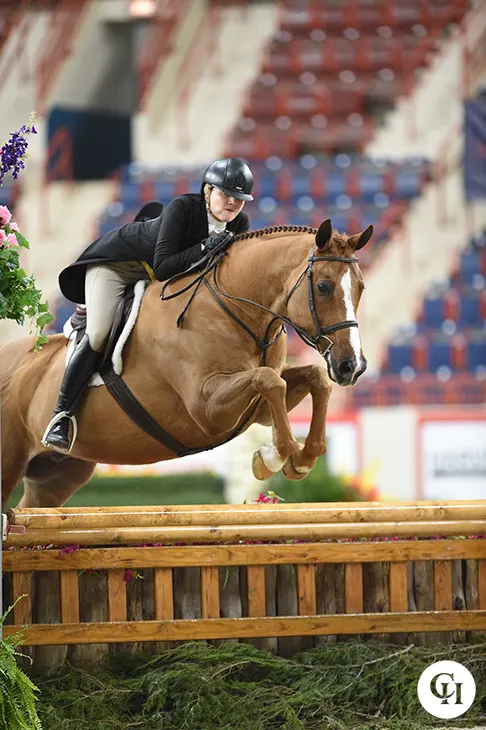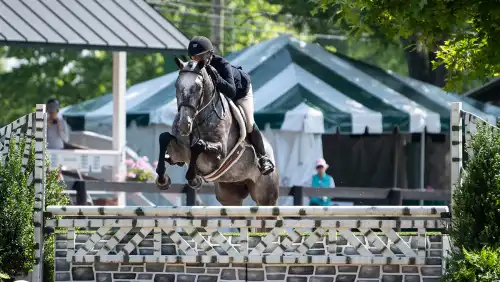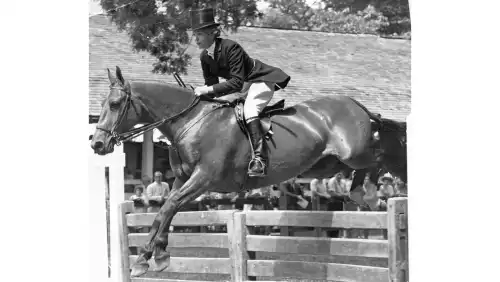As a little girl, objects in motion scared Vivian Palmer, particularly carousel horses. No merry association came from the merry-go-round, as the dual circling and vertical movement of the equine replicas worked little Palmer into tears.
“She didn’t quite understand where her body was in space,” her mother Laura Palmer said of Vivian, who was born with a pediatric vestibular condition. “So, she walked on her toes. She was very afraid of movement. She was afraid to ride a carousel horse. When she was a little girl, she would just cry if you got her anywhere near it.”
The vestibular system, which is located inside the ear, sends the brain signals about motion and spatial orientation, but Vivian’s didn’t function typically and required therapy. One of Vivian’s major symptoms was toe-walking, and as the condition progressed, Laura searched for a solution to get her daughter to stretch her calf muscles and heels down.
“The standard therapy or treatment for a child who continues to walk on their toes pretty late is that they serially cast them to stretch the heel cords,” Laura said. “We didn’t want her to be in a cast for a couple of years, so I was trying anything. I read on the Internet, way back when, that horseback riding can help children that had gait abnormalities and had abnormalities with the way that they walked.”
Vivian took up therapeutic riding at Thorncroft Equestrian Center in Malvern, Pennsylvania, at age 5 with the hope that sinking her heels down in the stirrups would help her out of the saddle.
“Because the way the horse walks mimics the natural gait of humans, being on the back of a horse taught her and normalized her walking pattern,” Laura said. “After two years of therapeutic riding at the Thorncroft Center in Malvern, Vivian’s vestibular condition was no longer measurable or detectable medically.”

Despite that initial fear of the carousel horses, Vivian developed a love for riding through Thorncroft. And when she was about 9, she wanted to explore it further, leading her to Jonathan Martin of Hunt Hill Farm in Chester Springs, Pennsylvania.
“Thorncroft was an incredible place, but I think once they had done what they could do for me, and I had healed, I got to the point where I wanted to do something that was a little bit more advanced, and they didn’t really do that there,” Vivian said. “So, I moved out to Hunt Hill Farm to ride with Jon, who at that time was kind of starting out.”
Another trainer told Martin, then 23, that they didn’t think Vivian would ever be able to jump, but that opinion didn’t deter them.
“We did not listen because she wanted to try,” Laura said. “And I kept saying, well, as long as you feel she’s ready, and it’s safe, then sure.”
When Vivian arrived at Hunt Hill, Martin remembered she had only trotted in straight lines in the ring. He taught her to canter and work over ground poles. One thing that became apparent was Vivian’s incredible balance on a horse.
“She used to ride the same way, kind of on the toe of her stirrup, [but] she always had great balance,” he said. “We always kept her well-mounted. [With] lots of practice and time in the saddle, she developed; the muscles changed.”
Martin used a lot of repetition, such as pole work and moving in and out of jumping position, to work on Vivian’s heels. When she progressed to crossrails, Martin knew she would succeed as a jumping rider.
“The real first time we did a crossrail or two, I thought she was going to be great,” he said. “She was never not going with the horses or anything. I never thought, ‘Oh, this is unsafe’ or, ‘She doesn’t look like she can stay with the horse or stay with the jump.’
ADVERTISEMENT
“When we did the first couple lessons, I wasn’t exactly sure just because she wasn’t even cantering yet,” he added. “But then once we got cantering—and I would set some poles just for her to trot over, post over them and [in] jumping position—and once I could see that she was fine staying with it, and she was able to stay centered up there and so forth, we just added a little bit more each time and increased.”
Riding healed Vivian by eliminating any lingering effects of her condition. She progressed up the hunter ranks like any other rider, from pre-children’s, to children’s and eventually the 3’3” and 3’6” juniors.
“We took up riding because she loved it so much, but we always thought, this will just be something she does because it’s good for her body, [and] it’s good for her mind,” Laura said. “We just had no idea that she was going to end up becoming a rider at the level that she has. We’re also just really blessed time and again with our trainer just finding incredibly wonderful animals.”
‘The Little Horse Almost Died’
One of those incredibly wonderful animals entered the Palmer household in the form of a 15.2-hand chestnut Hanoverian gelding (Perigueux—Fara). Earlier in life, Central Park competed in the 1.30- to 1.40-meter jumpers with Georgina Bloomberg. Lee Cesery rode “Park” in the amateur-owner divisions for a few years when he first transitioned to the hunter ring before deciding to sell him. Vivian had just started moving up to the 3’3” junior division and wanted a seasoned partner to go alongside her greener junior hunter Portrait. On the recommendation of Cesery’s trainer Jason Berry, Martin looked at Park for Vivian, and the family purchased him in February 2020.
“We tried him out, and he was just a love bug right from the very beginning,” said Laura. “Vivian almost immediately started showing him in the junior hunters right after that at the 3’3”.”
But one morning in early September 2021, Park just seemed off. Usually a very food-motivated soul, he went off his feed a little bit and seemed slightly lethargic. The barn staff called their veterinarian Tyra Crowley, VMD, to check on him, even though he didn’t display any major signs of severe colic such as thrashing or throwing himself to the ground. However, he didn’t respond to Banamine, and Crowley wondered if Park had a pedunculated lipoma, a fatty tumor on a stalk that can get wrapped around the small intestine, interfering with blood flow to that area of the intestine. Martin drove Park 35 minutes to the University of Pennsylvania’s New Bolton Center, and upon arrival the veterinarians there confirmed that Crowley’s instinct was correct.
“The staff at New Bolton thought a horse that is actually colicking and has what Tyra was suggesting he had, that he would have been such excruciating pain, and they thought he would have been a lot more demonstrative in terms of showing his pain,” Laura said. “But instead, he was really pretty stoic, and he was incredibly tough. So, they almost couldn’t believe it when they realized that it would have been the right call to bring him.”

The Palmers entrusted Martin to make the right call, and he needed to decide within minutes whether Park would undergo surgery.
“Honestly a lot of my equestrian friends, professionals, they kind of said, ‘Don’t put that poor horse through this,’ ” Martin noted. “I had a lot of negativity, saying that colic surgery is very hard on the horses, and really think about [whether] that’s what you want to do. Honestly, the surgeons at New Bolton were very positive because this is what they do all the time.”
Because of Park’s spirit and hardiness, Martin made the quick call to prepare the gelding for surgery.
“The surgeon at New Bolton told us that if we were 30 minutes later than what we were, that the intestine was all going to die from being strangled, and maybe we would have to put him down,” said Martin. “So we were also very lucky that we’re close. From the minute we got there to [him] being on the table, I bet you it was 15 minutes.”
“We found out the update about it while he was in surgery,” Vivian remembered. “And they were saying, they’re doing their best, but we don’t know if he’s going to wake up.”
The lipoma originated from the omentum and wrapped around his small intestine. Surgeons Maia R. Aitken, DVM, DACVS, DACVECC, and Alycia Crandall, DVM, removed approximately 6 feet of the small intestine, in addition to removing the region of the omentum where the lipoma originated. Though Park successfully underwent surgery, they gave him a 50-50 chance of returning to the show ring.
“Coming out of anesthesia is also very scary for these animals, because they can really hurt themselves when they’re trying to come out,” Laura said. “But he came through like a trooper, and some of the vet reports were just like, ‘We can’t believe this horse. We can’t believe his spirit. Just what a good patient he is. What a fighter he is,’ and how much he wanted to pull through.”
ADVERTISEMENT
The first 30 days post-surgery were critical, as his team watched to make sure he warded off infection and that his body could accept food again. He stayed at New Bolton for a few weeks and healed without any complications.
“I said, ‘If he starts to tell us then that he doesn’t want to do this, we’ll listen to him,’ ” said Martin. “But if we don’t get infection, and we feed him the wet hay and the wet feed, and his body takes to that, then I think we’ve got to listen to the horse, and that’s what we did.”
Park returned to Hunt Hill and remained on stall rest with daily walks. By December, he started on turn out and tack walk. Following veterinary orders, they slowly increased his work each week. And by the end of January 2022, Park was back in the show ring.
“I was kind of surprised with how quickly he came back to showing, because we had originally predicted that it was going to be much longer,” Vivian said. “He was out for about four months not being ridden, but we thought that it might take longer after that to bring him back into the show ring, and but he was just ready to go.
“The realization that he had come back and was fully himself again I think happened after the first show that I did on him, because I wasn’t sure how he was going to be for me, and he was just so good and so perfect,” she added. “He really felt like his old self again. I do remember, I’m thinking, ‘Wow, I’m so lucky that he is like this again.’ Even if I could never show him again, we were still going to keep him and love him.”
And by that fall, Vivian and Parker qualified and competed at the Pennsylvania National Horse Show and the National Horse Show (Kentucky). For the 2023 season, Vivian was going to make Park’s show schedule lighter as she focused on the 3’6” juniors with Portrait. But an injury halted that plan, and with Portrait recuperating, Park stepped up.
“We thought, ‘Well, we’ll bring him back. She’ll show him until she’s ready to move to the 3’6”, and then he’ll get to relax,” Laura said. “But then when Portrait was hurt, we thought, ‘My goodness, the little horse almost died—not only is he able to show, he wants to show.’ He’s just remarkable.”

Park and Vivian wrote a storybook ending to her junior career as the pair won the 3’3” small junior, 16-17, championship at the Adequan/USEF Junior Hunter National Championships—East (Michigan) as well as earning the championship title at the Pennsylvania National. They ended the year with the USEF 3’3″ small junior hunter, 16-17, national title.
“My heart was exploding with pride and just profound gratitude,” Laura said. “When I saw the look on her face when she realized in Traverse City [Michigan] that she won Junior Hunter Finals—when I saw the look on Jonathan’s face when he realized, and it really sank in—certainly it was one of the greatest moments in my life and in her dad’s life. I’m so happy for her and so grateful to Jonathan and grateful to Park.”
To Laura it is shocking and wonderful to think that a little horse who almost died two years ago and her child, who 15 years ago was too afraid to sit on a carousel horse, together became champion junior hunters. And to Vivian, she’s still in awe of how her final junior year played out.
“It’s just been really, really special because it’s never something that I would have expected to happen,” she said. “I did not start riding to compete.
“Even when I started showing, it was always supposed to be just a little fun hobby just to make myself happy and to enjoy time with the horses,” she added. “I never would have imagined that I would be going to a competition of that size and especially not to win.”
Do you know a horse or rider who returned to the competition ring after what should have been a life-threatening or career-ending injury or illness? Email Kimberly at kloushin@coth.com with their story.














